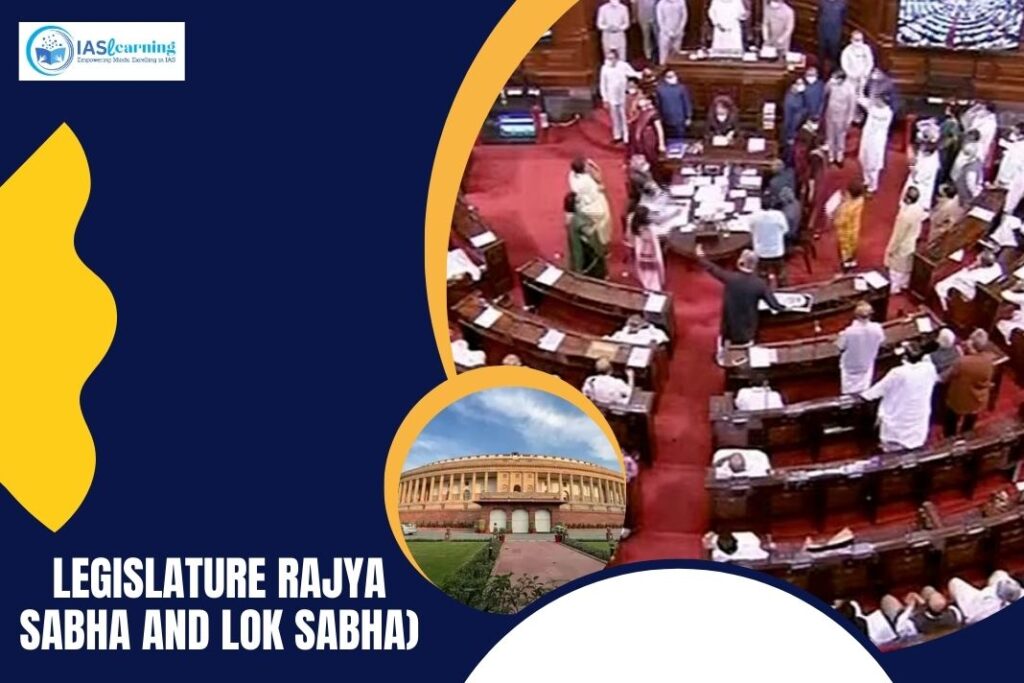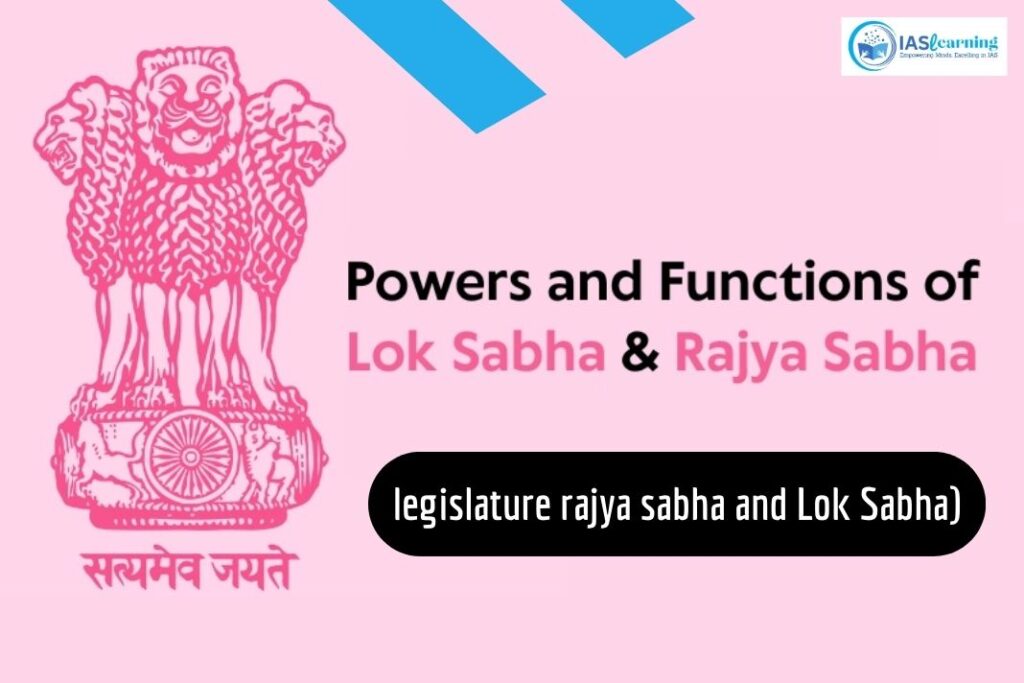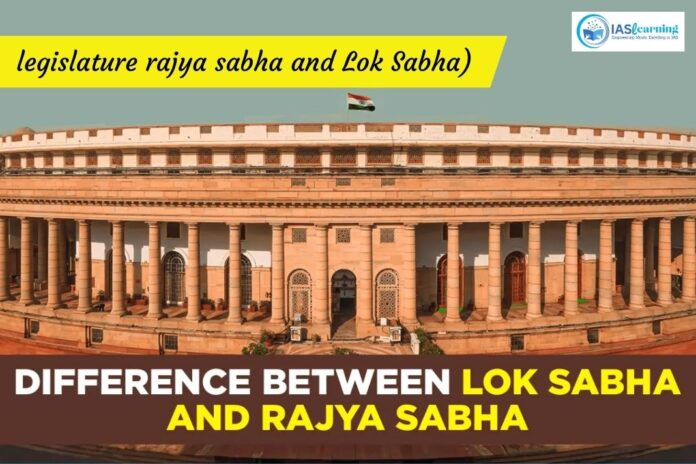Lok Sabha and Rajya Sabha
Delve into the heart of India’s parliamentary system by exploring the nuanced differences between Lok Sabha and Rajya Sabha. As integral components of the Indian Parliament, each house plays a unique role in shaping the country’s democratic landscape. Uncover the distinctions in composition, functions, and representations that define Lok Sabha and Rajya Sabha, gaining a comprehensive understanding of their pivotal contributions to the nation’s legislative process.”
“Explore the crucial nuances between Lok Sabha and Rajya Sabha, a vital topic for the UPSC IAS exam. This distinction forms an integral part of the Polity subject, encompassing both the Mains General Studies Paper-II and the Prelims General Studies Paper-1 syllabi. Enhance your preparation by understanding the unique features that differentiate these two houses of the Indian Parliament, contributing to a comprehensive grasp of the political landscape for UPSC aspirants.”
Comparison between Lok Sabha and Rajya Sabha

| Basis of Comparison | Lok Sabha | Rajya Sabha |
|---|---|---|
| Definition | Known as the lower house or the house of the people, Lok Sabha is responsible for passing bills and making laws to enhance governance in India. | Referred to as the upper house or the council of states, Rajya Sabha aims to safeguard the rights of diverse states within the nation. |
| Constitutional Provision | The composition of the Lok Sabha is governed by Article 81 of the Indian Constitution. | Article 80 of the Indian Constitution outlines the composition and role of Rajya Sabha. |
| Tenure Period | Typically, Lok Sabha has a tenure of 5 years. | Rajya Sabha is a permanent house of Parliament and does not have a fixed tenure. |
| Election for Membership | Members of Lok Sabha are elected through a voting process that involves the participation of the general public. | Rajya Sabha members are elected by representatives from state legislative assemblies and union territories. |
| Election Principle | Lok Sabha elections adhere to the principle of Universal Adult Franchise, allowing all eligible citizens to vote. | Rajya Sabha elections follow the principle of Proportional Representation through single transferable votes. |
| Strength | The strength of Lok Sabha ranges from 500 to 552 seats, with the current number set at 543. | Rajya Sabha has a strength ranging from 200 to 250 seats, and presently, it has 245 seats. |
| Minimum Age | To become a Member of Parliament (MP) in Lok Sabha, the minimum age requirement is 25 years. | The minimum age requirement for an MP in Rajya Sabha is 30 years. |
| House Representative | The Speaker of Lok Sabha presides over its proceedings and conducts its business. | The Vice-President serves as the Chairman of Rajya Sabha, overseeing its affairs and conducting its business. |
| Role | Lok Sabha plays a significant role in legislative activities and holds more influence in passing money bills compared to Rajya Sabha. | Rajya Sabha has exclusive powers to legislate on state subjects and create new all-India services, differentiating its role from Lok Sabha. |
Comparative Position between Lok Sabha and Rajya Sabha

| Comparative Position of Both Houses of Parliament | Original | Paraphrased |
|---|---|---|
| In a parliamentary system, the lower house is always given precedence. | In a parliamentary system, the lower house takes precedence. | In a parliamentary system, priority is accorded to the lower house. |
| Lok Sabha is the actual representative of the Indian people, as it is directly elected. Rajya Sabha, on the other hand, is chosen indirectly. | Lok Sabha is directly elected and represents the Indian people. In contrast, Rajya Sabha is indirectly chosen. | Lok Sabha, being directly elected, serves as the true representative of the Indian people, while Rajya Sabha is elected indirectly. |
| Rajya Sabha is a permanent body; Lok Sabha is elected for a 5-year term, extendable or dissolvable. | Rajya Sabha is a permanent body, while Lok Sabha is elected for a 5-year term, extendable or dissolvable. | Rajya Sabha remains a constant body, whereas Lok Sabha operates on a 5-year term, subject to extension or dissolution before completion. |
| Both Houses have equal authority regarding regular bills. Lok Sabha has an upper hand in case of disputes and a joint session. | Both Houses have equal authority over regular bills. Lok Sabha prevails in disputes and joint sessions due to its higher membership. | Both Houses possess equal authority in regular bills. Lok Sabha holds an advantage in disputes, gaining precedence in joint sessions with its larger membership. |
| Lok Sabha is more successful in controlling the Council of Ministers. | Lok Sabha is more effective in controlling the Council of Ministers. | Lok Sabha exhibits greater efficacy in overseeing and controlling the Council of Ministers. |
| Rajya Sabha can exercise power by debating policies, criticizing administration. | Rajya Sabha can influence policies and criticize the administration. | Rajya Sabha holds the capacity to impact policies and voice criticisms against the administration through debates. |
| Only Lok Sabha can pass a no-confidence motion, leading to the Council of Ministers’ resignation if passed. | Only Lok Sabha can pass a no-confidence motion, resulting in Council of Ministers’ resignation. | Exclusive to Lok Sabha, the authority to pass a no-confidence motion empowers it to force the resignation of the Council of Ministers upon approval. |
| Regarding constitutional amendments, presidential and vice-presidential elections, impeachment of key officials, both houses have comparable powers. | Both houses have similar powers in constitutional amendments, elections, and impeachment of key officials. | In matters of constitutional amendments, presidential and vice-presidential elections, and impeachment, both Lok Sabha and Rajya Sabha possess similar powers. |
| Lok Sabha has the upper hand in financial matters, while only Rajya Sabha can create a new All India Service or declare a State List subject to national concern. | Lok Sabha prevails in financial matters, and only Rajya Sabha can create a new All India Service or declare a State List subject to national concern. | In financial matters, Lok Sabha holds precedence, whereas only Rajya Sabha possesses the authority to establish a new All India Service or declare a State List subject to national concern. |
Key Aspects of Lok Sabha and Rajya Sabha

| Aspect | Lok Sabha | Rajya Sabha |
|---|---|---|
| Maximum Strength | 545 | 530 represent the States, 20 represent the Union Territories, 2 are nominated by the President from the Anglo-Indian Community, totaling 245. |
| Current Strength | 545 | 530 represent the States, 13 represent the Union Territories, 2 are nominated by the President from the Anglo-Indian Community, totaling 245. |
| Representation of Nominated Members | – | 12 members are nominated by the President. |
| Representation of Anglo-Indian Community (Nominated) | 2 members nominated by the President. | Not applicable. |
Lok Sabha and Rajya Sabha
| India’s Parliament is a bicameral legislature. Articles 79 to 122 of the Indian Constitution are covered by the provisions of the Indian Parliament. | India’s Parliament follows a bicameral structure outlined in Articles 79 to 122 of the Indian Constitution. |
| Lok Sabha | Members are directly elected by the people from the territorial constituencies in the states. |
| Election Principle used: Universal Adult Franchise | Members are elected through Universal Adult Franchise, allowing any Indian citizen aged 18 or above to vote. |
| Rajya Sabha | Members are elected by the elected members of state legislative assemblies. |
| Election Principle used: Proportional Representation by means of Single Transferable Vote | Members are elected using the principle of Proportional Representation through Single Transferable Vote. |
| Allotment of Seats: On the basis of population | The allocation of seats is based on population distribution. |
Lok Sabha:
Direct Election by the People:Members of Lok Sabha are directly elected by the citizens from territorial constituencies within the states.
Universal Adult Franchise:The election process in Lok Sabha operates under the principle of Universal Adult Franchise, allowing any Indian citizen aged 18 or above to participate in the electoral process.
Rajya Sabha:
Election by State Legislative Assemblies:
Unlike Lok Sabha, members of Rajya Sabha are not elected directly by the people. Instead, they are elected by the elected members of state legislative assemblies.
Proportional Representation:
The election principle employed for Rajya Sabha is Proportional Representation through the Single Transferable Vote method. This ensures a fair representation based on the proportion of votes received by each candidate.
Allotment of Seats Based on Population:
The allotment of seats in Rajya Sabha is done based on the population distribution among states. This principle aims to maintain a balance that considers the population size of each state.
Bicameral Structure:
The bicameral structure, as outlined in Articles 79 to 122, establishes a balance between the Lok Sabha and Rajya Sabha. While Lok Sabha directly represents the people, Rajya Sabha ensures the representation of states and union territories. The unique election principles adopted by each house contribute to a comprehensive and inclusive representation within the Indian Parliament.
This system reflects the framers’ intention to incorporate federal principles while maintaining a strong central government, fostering a parliamentary democracy that accommodates the diverse needs and interests of the Indian population and regions.
Difference between Lok Sabha and Rajya Sabha

| Difference between Lok Sabha and Rajya Sabha w.r.t Representation of States |
|---|
| Lok Sabha |
| Members of Lok Sabha are directly elected by the people from the territorial constituencies in the states. Universal Adult Franchise is used in elections. Any Indian Citizen of/above 18 years of age is eligible to vote. |
| Rajya Sabha |
| Rajya Sabha members are elected by the elected members of state legislative assemblies. Proportional Representation by means of a Single Transferable Vote is used in the elections. Seats are allotted based on the population. |
Feature
Lok Sabha
Number of nominated members: 2
Qualifications: Persons having special knowledge or practical experience in literature, science, art, and social service.
Manner of nomination: By the President
Rajya Sabha
Number of nominated members: 12
Qualifications: Persons having special knowledge or practical experience in literature, science, art, and social service. Those who have distinguished themselves in public service.
Manner of nomination: By the President from a list of persons recommended by the Prime Minister, the Speaker of the Lok Sabha, the Chief Justice of India, and the leaders of the various political parties in the Rajya Sabha.
Lok Sabha:
The Parliament of India consists of the President, the Rajya Sabha, and the Lok Sabha.
After Lok Sabha elections, a list of Members of Parliament (MPs) from each political party is prepared.
A political party must have a majority of elected MPs to form the government.
Out of the 543 elected members in Lok Sabha, a party needs at least half, i.e., 272 members or more, to have a majority.
Functions of Lok Sabha:
Amend Money Bills: Lok Sabha has the authority to make amendments to Money Bills.
Enact and Introduce Bills: It is responsible for enacting and introducing both money and non-money bills.
Approval for Financial Matters: Provides approval for proposals related to taxation, budget, and financial statements.
Check on the Executive: Exercises checks on the executive through the power of asking questions, supplementary questions, resolutions, motions, and passing no-confidence motions.
Initiate Removal of Vice President: Has the authority to initiate the process of the removal of the Vice President.
The Lok Sabha, as a vital component of the Indian Parliament, plays a central role in the country’s democratic governance. Comprising elected representatives from across the nation, Lok Sabha holds significant powers and functions crucial to the legislative process and the overall functioning of the government.
Representation and Formation of Government:
Lok Sabha is the primary legislative body where Members of Parliament (MPs) are elected by the citizens of India through a general election.
The political party or coalition that secures a majority in Lok Sabha forms the government, with its leader becoming the Prime Minister.
Legislative Functions:
The Lok Sabha holds the authority to amend Money Bills, which are crucial for the financial operations of the government.
It is responsible for introducing and enacting bills, both related to financial matters (Money Bills) and general legislation (non-money bills).
Approval for Financial Proposals:
The Lok Sabha exercises its financial oversight by providing approval for proposals related to taxation, budget, and financial statements. This process ensures transparency and accountability in fiscal matters.
Executive Oversight:
Lok Sabha acts as a check on the executive branch through various mechanisms such as questioning the government, raising supplementary questions, presenting resolutions, and initiating motions.
The power to pass a vote of no-confidence is a crucial tool for holding the government accountable, and it underscores the principle of parliamentary democracy.
Initiating Vice President’s Removal Process:
In a unique constitutional provision, Lok Sabha has the authority to initiate the process for the removal of the Vice President of India, demonstrating its role in the larger constitutional framework.
Rajya Sabha:
Rajya Sabha, one of the two houses of the Indian Parliament, is unique in its composition and role. Representing the states of India, Rajya Sabha plays a crucial part in the legislative process, ensuring a comprehensive and balanced approach to lawmaking.
Composition and Election:
The representatives of the states form the Rajya Sabha, reflecting the federal structure of the Indian Constitution.
Members are elected by the elected members of the Legislative Assemblies of various states, contributing to the representation of regional interests.
Review and Alteration of Laws:
Rajya Sabha has a significant role in reviewing and, if needed, altering laws initiated by the Lok Sabha. This process ensures a thorough examination of legislation from multiple perspectives.
Initiation of Legislation:
Specific legislation can be initiated in the Rajya Sabha. For a bill to become law, it must pass through both houses of Parliament, emphasizing the collaborative nature of the legislative process.
Composition Overview:
Presently, Rajya Sabha comprises 233 elected members and 12 members nominated by the President, further ensuring diverse representation.
Functions of Rajya Sabha:
Approval of Non-Money Bills:
Rajya Sabha has the authority to approve non-money bills, contributing to the legislative scrutiny and refinement process.
Lawmaking Authority:
Rajya Sabha can make laws on matters included in the concurrent and union lists, ensuring its participation in a wide array of legislative activities.
Constitutional Amendments:
The approval of constitutional amendments is within the purview of Rajya Sabha, highlighting its role in shaping the fundamental framework of the nation.
Oversight and Accountability:
The house has the power to ask questions to the executive, present resolutions, and motions, thereby actively participating in oversight and ensuring accountability.
Election and Removal Powers:
Rajya Sabha actively participates in the election and removal processes of key constitutional positions, including the Vice President, President, and judges of the Supreme Court and High Court.
FAQs on Lok Sabha and Rajya Sabha:
What is Lok Sabha?
Lok Sabha is the lower house of the Indian Parliament and represents the people through direct elections.
What is Rajya Sabha?
Rajya Sabha is the upper house of the Indian Parliament, representing the states and union territories.
How is Lok Sabha formed?
Members of Lok Sabha are directly elected by the citizens of India through general elections.
How is Rajya Sabha formed?
Members of Rajya Sabha are elected by the elected members of the Legislative Assemblies of states and union territories.
What is the composition of Lok Sabha?
Lok Sabha has a maximum strength of 545 members, with 543 elected and 2 nominated members.
What is the composition of Rajya Sabha?
Rajya Sabha has a maximum strength of 245 members, with 233 elected and 12 nominated members.
How is the government formed in Lok Sabha?
The political party or coalition with a majority in Lok Sabha forms the government, and its leader becomes the Prime Minister.
What role does Lok Sabha play in legislation?
Lok Sabha has the power to amend money bills, introduce and enact bills, and approve proposals related to taxation and budget.
What is the role of Rajya Sabha in legislation?
Rajya Sabha reviews and alters laws initiated by Lok Sabha, initiates specific legislation, and plays a crucial role in approving non-money bills.
How does Rajya Sabha contribute to constitutional amendments?
Rajya Sabha has the authority to provide approval for constitutional amendments, influencing the fundamental framework of the nation.
Can Rajya Sabha participate in the election and removal of constitutional positions?
Yes, Rajya Sabha actively participates in the election and removal processes of key constitutional positions, including the Vice President, President, and judges of the Supreme Court and High Court.
How is the Vice President removed?
Both Lok Sabha and Rajya Sabha play a role in the removal of the Vice President through a resolution supported by a majority of members.
Know more..




